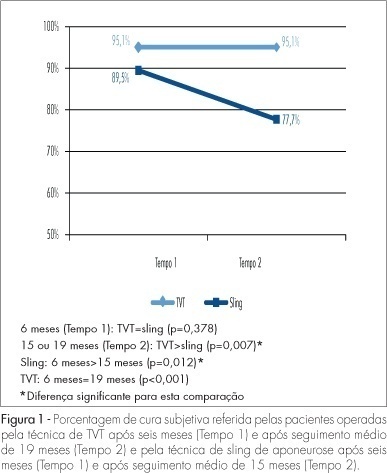Summary
Revista Brasileira de Ginecologia e Obstetrícia. 2013;35(7):290-294
DOI 10.1590/S0100-72032013000700002
PURPOSE: To identify the predictive factors for voiding dysfunction after transobturator slings. METHODS: We retrospectively reviewed the records of all patients who underwent a transobturator sling between March 2003 and December 2008. A total of 514 women had available data with at least a six-week follow-up. Patients' demographics, preoperative symptoms, urodynamic testing including multichannel voiding studies and surgical variables were tabulated. Voiding dysfunction was defined by a catheterized or ultrasonographic postvoid residual greater than 100 cc (≥six weeks after the procedure) associated with any complaints of abnormal voiding. Univariate logistic regression analysis was performed with respect to postoperative voiding dysfunction. RESULTS: The patient population had a mean age of 58.5±12.9 years. Thirty-three out of 514 patients (6.4%) had postoperative voiding dysfunction according to our definition, and 4 (0.78%) required sling transection. No differences were observed between normal and dysfunctional voiders in age, associated prolapse surgery, preoperative postvoid residual, preoperative urinary flow rate, prior pelvic surgery, and menopausal status. Valsalva efforts during the preoperative pressure flow study was the only predictive factor for postoperative voiding dysfunction, 72.4% dysfunctional versus 27.6% normal (p<0.001). CONCLUSION: Preoperative Valsalva maneuver during the micturition could identify those at risk for voiding dysfunction after transobturator sling, and it should be noted during preoperative counseling.
Summary
Revista Brasileira de Ginecologia e Obstetrícia. 2008;30(3):127-134
DOI 10.1590/S0100-72032008000300005
PURPOSE: to compare sling operations of aponeurosis and tension-free vaginal tape (TVT) for the correction of stress urinary incontinence (SUI) regarding: the rates of subjective and objective healing, the mobility of the bladder neck with ultrasonography, the variation of the absorbent test, the urodynamic alterations and the incidence of complications. METHODS: eighty patients with SUI were selected. Among them, 61 underwent a TVT surgery and 19, an abdominal rectum sling operation of aponeurosis. Average age, index of body mass and parity were 50.1 years old, 29.7 kg/m² and 4.1 deliveries (median=3) for the patients with aponeurosis sling, and 51.7 years old, 28.1 kg/m² and 4.1 deliveries (median=3) for the ones with TVT. All of them have undergone anamnesis, physical examination, bladder neck ultrasonography, absorbent test and urodynamic evaluation before and at least six months after the surgery. After 15 or 19 months and after about four or five years, they were again interviewed concerning the surgery results. RESULTS: after six months, 96.7% of the women with TVT and 89.5% of the ones with sling thought they were healed in the subjective evaluation. Nevertheless, after 15 to 19 months, the TVT Group kept the same subjective healing rate, while among the Sling Group the rate decreased to 77.8%. There was a significant decrease in the mobility of the neck bladder that was similar in both groups and an improvement in the absorbent test. At the end of the urodynamic study, 93.4% of the women from the TVT Group and 78.9% of the ones from the Sling Group were classified as having an objective healing. The average time of bladder probing was higher in the Sling Group. Urinary retention was observed in 42.1% of the sling cases and in 9.8% of the TVT's. The rates of late healing were 90% for TVT and 55.6% for sling. CONCLUSIONS: TVT surgery provided better subjective healing after 15 or 19 months, but the rate of objective healing was the same in both techniques at that time. Among the complications detected, the urinary retention was higher in the Sling Group, in the post-surgery period.
